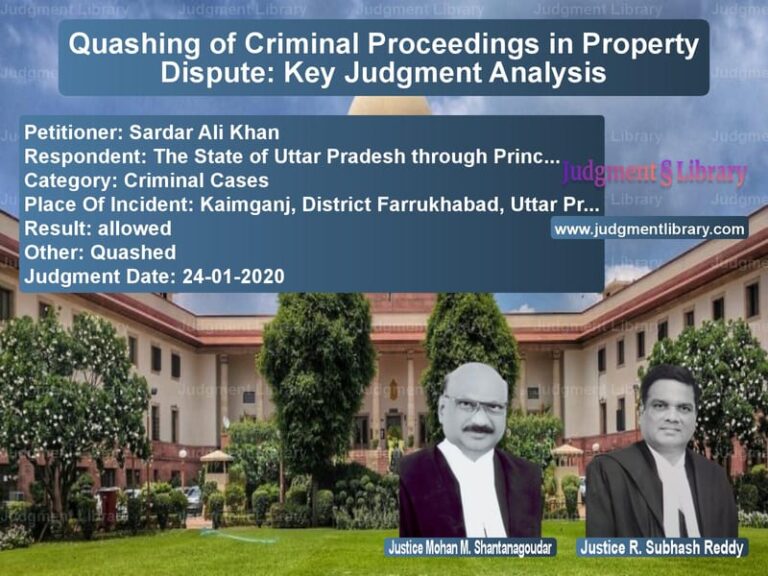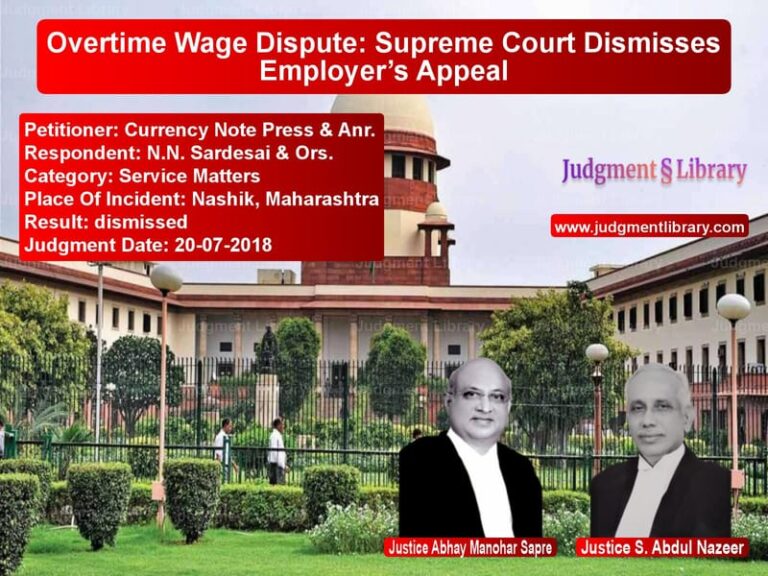Discharge from Army Service Due to Red Ink Entries: Supreme Court Upholds Dismissal
The Supreme Court of India, in the case of Sep. Satgur Singh vs. Union of India & Others, ruled on the discharge of an army personnel due to multiple red ink entries under the Army Act, 1950. The case revolved around whether repeated disciplinary infractions justified dismissal and whether procedural fairness was maintained.
Background of the Case
The appellant, Sepoy Satgur Singh, was discharged from the Indian Army after serving for 11 years, 9 months, and 15 days due to accumulating seven red ink entries for various disciplinary infractions. A show-cause notice was issued to him on September 22, 2004, highlighting that he had proven himself to be undesirable for retention in service.
His misconduct record included:
- Two infractions in 1995
- One infraction in 1998
- Two infractions in 2000
- Two infractions in 2004
The show-cause notice mentioned disciplinary punishments such as rigorous imprisonment (RI) for different durations, ranging from 2 to 28 days, under various provisions of the Army Act.
Key Legal Issues Considered
- Whether multiple red ink entries justify discharge from service under Army regulations.
- Whether procedural fairness was followed before discharging the appellant.
- Whether a formal court of inquiry was necessary before discharging an army personnel.
Arguments by the Petitioner (Sep. Satgur Singh)
The appellant argued:
- He was facing family difficulties and had committed mistakes due to personal circumstances.
- He was not given an opportunity to reform or improve his conduct.
- His dismissal was harsh and did not consider his long tenure of service.
- As per the Supreme Court’s ruling in Veerendra Kumar Dubey vs. Chief of Army Staff, mere red ink entries should not automatically lead to dismissal.
Arguments by the Respondent (Union of India & Army Authorities)
The respondents contended:
- The appellant was a habitual offender and had repeatedly violated discipline.
- He was given multiple chances to correct his behavior but failed to do so.
- His presence in the armed forces was detrimental to discipline and operational efficiency.
- The Army Instructions dated December 28, 1988 allow for discharge based on repeated red ink entries.
Supreme Court’s Observations
The Supreme Court analyzed procedural fairness and army regulations, making the following key observations:
- Army personnel are expected to maintain high levels of discipline, and repeated offenses demonstrate an inability to comply with military standards.
- The Army Instructions of 1988 provide a mechanism for discharging personnel who exhibit habitual misconduct.
- The appellant was given a show-cause notice and had an opportunity to explain his actions.
- A formal court of inquiry is not necessary before dismissing personnel under Army Rule 13 when repeated disciplinary violations exist.
- “A Member of the Armed Forces cannot take his duty lightly and abstain from duty at his will.”
Final Judgment
The Supreme Court dismissed the appeal and upheld the appellant’s discharge, ruling:
“The appellant is a habitual offender, and the repeated absence from duty justifies the decision to discharge him from service. The disciplinary record supports the conclusion that he is unfit for continued military service.”
Implications of the Judgment
- For Armed Forces Personnel: The ruling affirms that multiple disciplinary violations can lead to dismissal, and leniency will not be shown for habitual offenders.
- For Military Authorities: The judgment validates the use of red ink entries as a criterion for determining the undesirability of personnel.
- For Judicial Precedent: The ruling reinforces that show-cause notices and preliminary inquiries are sufficient procedural safeguards before discharging an army personnel.
Conclusion
The Supreme Court’s decision in this case upholds the principle that military discipline must be maintained strictly and that repeated misconduct warrants dismissal. The ruling serves as a deterrent against repeated infractions in the armed forces and confirms that habitual offenders cannot claim undue leniency.
Petitioner Name: Sep. Satgur Singh.Respondent Name: Union of India & Others.Judgment By: Justice L. Nageswara Rao, Justice Hemant Gupta.Place Of Incident: Chandimandir, Chandigarh.Judgment Date: 02-09-2019.
Don’t miss out on the full details! Download the complete judgment in PDF format below and gain valuable insights instantly!
Download Judgment: Sep. Satgur Singh vs Union of India & Oth Supreme Court of India Judgment Dated 02-09-2019.pdf
Direct Downlaod Judgment: Direct downlaod this Judgment
See all petitions in Disciplinary Proceedings
See all petitions in Public Sector Employees
See all petitions in Termination Cases
See all petitions in Judgment by L. Nageswara Rao
See all petitions in Judgment by Hemant Gupta
See all petitions in dismissed
See all petitions in supreme court of India judgments September 2019
See all petitions in 2019 judgments
See all posts in Service Matters Category
See all allowed petitions in Service Matters Category
See all Dismissed petitions in Service Matters Category
See all partially allowed petitions in Service Matters Category







